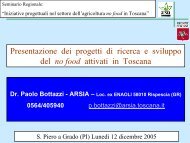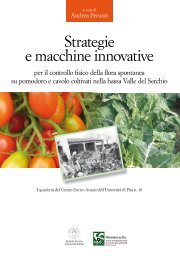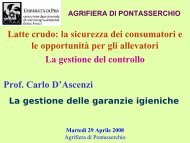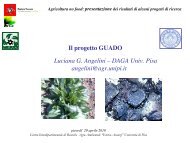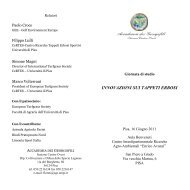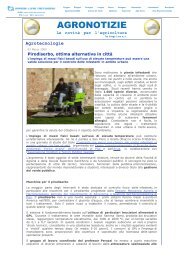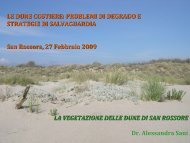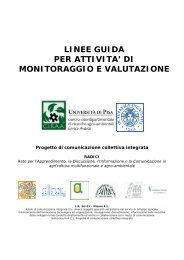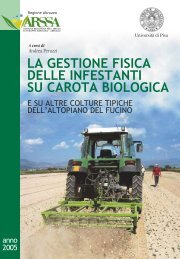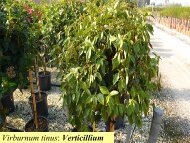Le colture dedicate - Centro Interdipartimentale di Ricerche Agro ...
Le colture dedicate - Centro Interdipartimentale di Ricerche Agro ...
Le colture dedicate - Centro Interdipartimentale di Ricerche Agro ...
You also want an ePaper? Increase the reach of your titles
YUMPU automatically turns print PDFs into web optimized ePapers that Google loves.
70 QUADERNO ARSIA 6/2004<br />
Canna<br />
Punti <strong>di</strong> forza. È senz’altro la specie da energia più<br />
produttiva tra quelle sperimentate nell’ambiente<br />
me<strong>di</strong>terraneo; grande adattabilità nei confronti<br />
dei <strong>di</strong>versi tipi <strong>di</strong> terreno e a con<strong>di</strong>zioni<br />
udometriche caratterizzate da ridotte precipitazioni;<br />
è specie poliennale, in grado <strong>di</strong> mantenere<br />
costante ed elevata la sua produttività per<br />
molto tempo; è una componente tipica del<br />
nostro paesaggio rurale; protegge il terreno<br />
dall’erosione in maniera molto efficace.<br />
Punti <strong>di</strong> debolezza. Il costo <strong>di</strong> messa in opera dei<br />
rizomi è ancora molto alto sia per il prezzo dei<br />
rizomi stessi (che si ridurrà con il <strong>di</strong>ffondersi <strong>di</strong><br />
vivai produttori) che per la non perfetta meccanizzazione<br />
<strong>di</strong> questa operazione; è specie abbastanza<br />
invasiva ed è necessaria un’accurata operazione<br />
<strong>di</strong> bonifica prima <strong>di</strong> intraprendere la<br />
coltivazione <strong>di</strong> altre <strong>colture</strong>. La biomassa è<br />
caratterizzata da un elevato contenuto in ceneri<br />
con un tenore in silice piuttosto elevato.<br />
Bibliografia<br />
AA.VV. (2004) - Tecniche Innovative Sostenibili <strong>di</strong> produzione<br />
e trasformazione <strong>di</strong> <strong>colture</strong> energetiche e non food,<br />
ISCI, Bologna.<br />
AA.VV. (1999) - <strong>Le</strong> coltivazioni da biomassa per un’energia<br />
alternativa. Agricoltura, anno XLVII (293): 57-99.<br />
ABBATE V., PATANÈ C. (1996) - Biomass crop for energy of<br />
possible introduction to Sicily. Proc. 9 th EU Bioenergy<br />
Conference, Biomass for energy and environment,<br />
Copenhagen (DK), 24-26 June 1996, Elsevier Science<br />
Limited.<br />
ACAROGLU M., AKSOY A.S. (1998) - Third year growing<br />
results of C 4 energy plant Miscanthus sinensis in producing<br />
energy from biomass. Proc. 10 th EU Bioenergy<br />
Conference, Biomass for Energy and Industry, Wurzburg<br />
(D), June 1998.<br />
ALLEGRO G. (1999) - Il ritorno della farfalla bianca del<br />
pioppo (<strong>Le</strong>ucoma salicis L.). Sherwood, 49: 43-46.<br />
ALLEGRO G. (1997) - Conoscere e combattere il punteruolo<br />
del pioppo (Cryptorhynchus lapathi L.). Sherwood-<br />
Foreste e alberi oggi, 29: 33-38.<br />
ALLEGRO G., DELLA BEFFA G. (2001) - Un nuovo problema<br />
entomologico per la pioppicoltura italiana: Platypus<br />
mutauts Chapuis (coleoptera, platypo<strong>di</strong>dae). Sherwood,<br />
66: 31-34.<br />
SRF <strong>di</strong> pioppo<br />
Punti <strong>di</strong> forza. È in grado <strong>di</strong> esprimere livelli produttivi<br />
interessanti anche sul piano quantitativo,<br />
ma il suo principale vantaggio è senz’altro<br />
quello <strong>di</strong> produrre una biomassa <strong>di</strong> primissima<br />
qualità: il contenuto in ceneri e la silice quivi<br />
contenuta sono estremamente ridotti rispetto<br />
alle <strong>colture</strong> da energia erbacee; la biomassa può<br />
anche avere usi alternativi (cellulosa, truciolati<br />
ecc.); la coltura rappresenta una buona protezione<br />
per il terreno dai fenomeni erosivi e un<br />
ottimo rifugio per un gran numero <strong>di</strong> animali.<br />
Punti <strong>di</strong> debolezza. La meccanizzazione della raccolta,<br />
lo stoccaggio e la conseguente logistica<br />
devono essere ancora perfezionate; molti tentativi<br />
<strong>di</strong> messa a punto <strong>di</strong> macchinari specifici<br />
sono ancora troppo costosi o non idonei; dubbi<br />
sulla lunghezza del ciclo colturale in ambienti<br />
me<strong>di</strong>terranei; rispetto ad alcune <strong>colture</strong> erbacee<br />
(ad esempio, canna e cardo) richiede un maggior<br />
numero <strong>di</strong> interventi fitosanitari.<br />
ALLEGRO G., GIORCELLI A. (2004) - Trattamenti per la<br />
<strong>di</strong>fesa fitosanitaria dei vivai.<br />
ANGELINI L., CECCARINI L., BONARI E. (1999) - Resa, composizione<br />
chimica e valutazione energetica della biomassa <strong>di</strong><br />
specie erbacee annuali per la produzione <strong>di</strong> energia. In:<br />
BONA S. (ed.), Atti XXXIII Convegno Annuale Società<br />
Italiana <strong>di</strong> <strong>Agro</strong>nomia. <strong>Le</strong> <strong>colture</strong> non alimentari. <strong>Le</strong>gnaro<br />
(Pd), 20-23 settembre 1999.<br />
ARMSTRONG A., JOHNS C., TUBBY I. (1999) - Effect of spacing<br />
and cutting cycle on the yield of poplar grown as an energy<br />
crop. Biomass and Bioenergy, 17: 305-314.<br />
ARNOUX M. (1974) - Recherches sur la canne de Provence<br />
(Arundo donax L.) en vue de sa production et de sa transformation<br />
en pate a papier. Annales Ammelioration des<br />
Plantes, 24 (4): 349-376.<br />
BACHER W. (1998) - Poplar (Populus spp.). In: N. BASSAM<br />
(ed.), Energy plant species. James and James, London,<br />
pp. 203-206.<br />
BALLARD B., STEHMAN S., BRIGGS R.D., VOLK T.A., ABRAH-<br />
AMSON L.P., WHITE, E.H., (1998) - Aboveground Biomass<br />
Equation Development for Five Salix Clones and One<br />
Populus Clone. Biomass Power for Rural Development.<br />
BALSARI P., AIROLDI G. (1999) - Valutazione energetica ed<br />
economica <strong>di</strong> una coltivazione <strong>di</strong> pioppo per la produzio-




